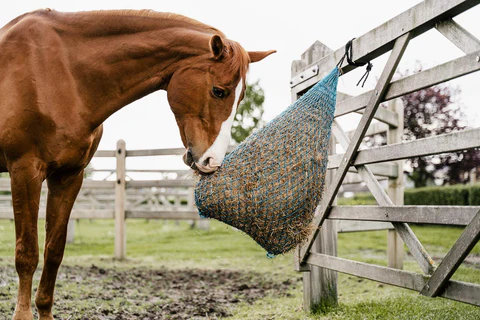In horses and ponies with laminitis, the layers of tissue between the hoof wall and the coffin bone are inflamed. Laminitis is very painful for your horse or pony and, in the worst case, can be life-threatening. In other words, no picnic. Hence, it is better to prevent than to cure laminitis — and this is how.
1. Provide your horse with an adapted feeding plan
It all starts with a low-sugar, high-fibre diet. Get rid of cereals as much as you can and give your four-legged friend plenty of roughage. First soak your horse’s hay and check that it does not contain too much sugar. Make sure that he or she does not eat too much grass and plant a grass type that contains little sugar. Provide your horse with essential vitamins and minerals by feeding a daily supplement containing as many natural ingredients as possible.
2. Make sure your horse gets enough exercise
Overweight horses are at greater risk of laminitis. So make sure that your horse or pony gets enough exercise and aim for a moderate Body Condition Score. Adequate exercise also promotes blood circulation in the hooves, which is also important to decrease the risk for laminitis.
3. Take extra care of horses who suffered from laminitis in the past
Sensitive animals are at greater risk of recurrent episodes of laminitis. Horses that have suffered from the disease in the past also need extra attention.
4. Keep an eye on your horse’s pasture
Is your horse on pasture? Then make sure to keep the sugars at bay.
This is how:
- Choose the right type of grass. That means a grass mixture especially for horse pastures. Rye grass, for instance, is very suitable for cows that have to produce a lot of milk, but not for horses.
- Let your horse graze only on pastures that get enough nutrients and water so that sugar levels do not build up in the leaves. By the way, it is not true that your horse is at lesser risk of laminitis in a field with short grass, because short grass often contains too much fructan.
- Don’t leave your horse on pasture too long. What is too long, you ask? That depends on the horse. The bottom line is that the animal should not become overweight. If he or she gains too much weight too quickly, let your horse move more and graze less.
- Use a grazing muzzle. Your horse will automatically eat less grass, so the muzzle acts as a portable slowfeeder.

5. Adjust the time schedule for when your horse is allowed on pasture.
Tip: during spring, horses and ponies are at extra risk of laminitis. Night frost and sunny days are a dangerous combination for those hooves. Some guidelines below.
Summer
- Low risk: cloudy and warm (around 15°C / 60°F), best grazing time: afternoons and evenings, grass with sufficient nutrients and water
- High risk: warm, sunny days. Best grazing time: night and morning. Short, stressed grass, drought
Spring & Autumn
- Low risk: cloudy and warm (around 15°C / 60°F)
- Moderate risk: cloudy and cold (< 15°C / 60°F)
- High risk: sunny and cold (< 15°C / 60°F), night frost and sun means highest risk in the morning.
Winter
- Moderate risk: cloudy and cold (< 5°C / 40°F)
- High risk: cold frosty weather and bright sunshine, night frost and sun means highest risk in the morning
Want to know more about laminitis? We don’t claim to be experts, but—well, actually we are. Read more about what laminitis is, how to recognise a horse with laminitis, or find out how to help an afflicted horse or pony.


